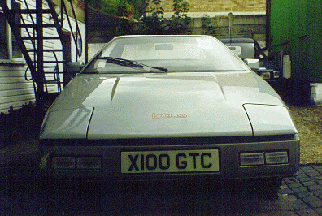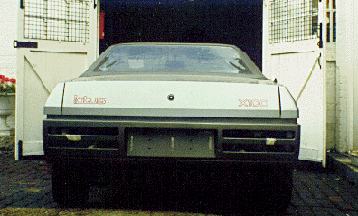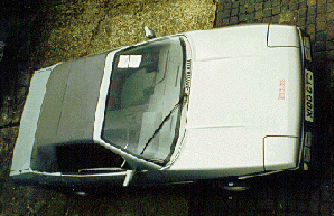
Front View

Rear View
The Missing Elan M90
Part 1: History and Background
"What is an M90?" After all the comprehensive "Lotus Book" skips from M89 (Excel) to M91 (Formula 1 race car) with no entry for the M90 or any mention of its designer, Oliver Winterbottom, in the index. The former omission is not surprising since the M90 project (also known as X100) never got further than clay models and one prototype. However, the second omission is not as understandable, since Oliver Winterbottom was responsible for the wedge shaped designs of the Elite and Eclat.
In March 1981, Oliver Winterbottom was brought back to Lotus from working as a freelance with TVR, where he had designed the Tasmin. The design goal was to develop a low(er) end sports car to compliment the Excel (derived from the Eclat) and Esprit, and bring profitability back to Lotus. Like the Excel, the new Elan was to have Toyota components, specifically it would use the 115 bhp 2-liter single overhead cam Celica engine and rear-drive transmission.
Although the M90 was to be the new Elan and hence one would image would be a convertible, the early designs were all of a fixed head coupe. The first iteration was deemed to look too much like the Porsche 928, due to its fastback shape. A revisions were made to give the car a notch back style, before a true hatch back was settled on for making into a full size model. This model was displayed at Hethel, along with contemporary TR7 and Mazda RX-7 models. The M90 was smaller than either, but with a more spacious interior. Chapman was not impressed, but gave the go ahead to try and use this model to raise the financial backing. Unfortunately, the backing didn't come and Chapman died in 1982.
The post Chapman era for Lotus was bleak with creditors snapping at their heals. However, Mike Kimberley, then the Managing Director and member of the Lotus Board, arranged for significant financial support from Toyota. This in turn led to David Wickens of British Car Auctions taking a controlling interest in Lotus. These events reinvigorated the M90 project and Winterbottom went back to work. The new M90 was to have the Toyota 4A-GE 1.6 Liter, twin overhead cam, 16 valve, engine which allowed it to be shorter than before. During this time, David Wikens decided to re-name the M90 as X100 (of course M100 was later used for the front wheel drive Elan). However, most people, including Oliver Winterbottom, still call this car as the M90. Despite some meddling with Lotus traditions (like changing the Lotus badge) Wickens did give the go ahead in 1984 for one car to be made. The prototype was to be a convertible, despite the majority of the previous work being aimed to a 2+2 fixed head coupe. The car was produced to a high level of finish, with full interior, and painted two-tone silver-gray. However, the M90 was to go no further. By 1985 Peter Stevens was working on a front wheel drive Elan. The one and only M90 thus languished in a warehouse at the Lotus factory at Hethel.
Part 2: Purchase and Shipping
During the summer of 1998 Lotus Cars decided to auction of their Museum and related collection at the Coys Auction at the Silverstone International Historic Festival. Among the list of desirable cars was the M90 prototype. I realized that this was the cute wedge shaped convertible that I had seen at the factory and that is described in Mark Hughes's excellent book on the M100 Elan. The next day I had phoned Coys in South Kensington (London) to find out more details of the sale and how they would accept payment for any successful bid. I also discussed with Coys about the regulations for shipping cars in US - not an easy thing as all us want to be Elise owners know! The next Friday I was flying from Brussels to Gatwick. Early on Saturday we headed out on one of those rare British hot summer days - almost like being in Texas in March!
After I registered for the auction I spent a couple of hours looking in detail at several of the cars, including: the Etna show car and the first pre-production Esprit. After much lying under them I realized that any chance of using these as more than a museum piece was going to take more than my rudimentary mechanical skills. Not so the M90, which was only missing 1 seat (drivers!), the hand brake, and the gear stick. Also as I later found out the car keys! The auction was actually rather fun, and after signing all the paper work, the M-90 was mine.
Now came the worrying part of the process: how to get the M90 into the states and find the remaining parts. My advise to anyone else doing this type of thing is ask as many different Government agencies as possible. While making AT&T wealthy, I phoned the DoT in Washington DC who gave me all the details of which parts would have to meet DoT code. This is actually a surprisingly short list and includes only the glass, the tires, brake hose, seat belts and the lens covers for all the lights. I then contacted the US customs in Houston, who helped me in making sure that I had all the correct paper work in place. Both of the gentlemen I dealt with were pleasant, helpful, and interested. In short they are definitely not your usual government bureaucrat. Despite this careful preparation, there would be several things that were needed to be done prior to shipping. I contacted Mike at Redline in Caterham (UK) and he was willing to carry out the prep-work prior to shipping (see the accompanying photographs). Some may know of Redline as being the official suppliers of parts for Lotus Sevens.
I have since found out that having good shipping and customs agents is half the solution to the import nightmare. Wanda at All Port Services in Houston arranged all the paper work and payments without any fuss. Without people like this you don't get a car into the US!
Once in the US, the restoration has started. As can be seen from some of the accompanying photographs, the car is in generally good shape, but is going to require a lot of work. The first job is to remove the body from the classic Lotus backbone chassis in order to clean and re-paint. Since this was a one-off the chassis was never galvanized, but simply painted.
Part 3: Which parts bin did Lotus raid this time?
So what have I learnt so far about this unusual car? First the engine is a Toyota 4A-GE 1.6 L, twin overhead cam mated to a Toyota gear box. The engine was also used in the MR2 and as such is easily modified for performance. The suspension is also Toyota and the same as the Excel. The instrument pod is Opel (GM Europe) Monza which required there to be an adapter for the oil pressure to mate it with the Toyota sender. In somewhat typical Lotus fashion, this was engineered at the limit and cracked after less than 1500 miles. Untypical, for Lotus, the radiator is over engineered, coming from a 1750 cc Austin Allegro. This choice was to allow for the addition of air-conditioning. Other sources of parts that I have been able to ascertain are as follows. The rear lights are from an Austin Martin Lagonda; the front indicators are Ford Fiesta reversing lights turned upside-down with yellow bulbs. In addition, to the engine and 5-speed gear box the final drive, heater, switch gear, headlight pods, and wheels all come from various Toyota cars. Finally, the M100's door handles are clearly the same as its M90 forbear.
The shape of the M90 was, and still is, criticized as being not as exciting as the M100. However, this is with hindsight and is a matter for some personal preference. What is often not appreciated is that in addition to the parts-bin raiding the M90 has several features that would have allowed it to be easily produced and user friendly. Unlike the majority of cars, the outside door panels is removed rather than the inside. This makes work inside the door panel simple and quick. Something that M100 owners would appreciate. The body panels were designed such that the lower body panels (dark gray on all cars) would be made of RRIM and easily replaced in the case of an accident. The upper panels would be GFRP and colored with the standard range. This sounds like a Saturn and similar modern cars from Detroit and Japan. For those interested in the technical details of the M90 they are provided in the Table. While the 1587 cc engine only produces 123 Bhp (@ 6600 rpm) the overall weight of 1973 lbs results in a power to rate ratio comparable to the original Elan and not to far from the turbocharged version of the Elan M100.
A feature that Winterbottom carried over from the TVR Tasmin was the Targa/convertible top. The roof comes in two sections. A Taga style center section which is removed and stored in the boot (trunk) and a rear section that folds down to give a true convertible. Unlike other Lotus soft tops the interior is fully lined.
1984 Lotus Elan M90

Front View

Rear View

Interior

Side View

Top View
Technical Data
Engine 1587 cc Type Toyota 4A-GE No. cylinders 4 Redline 7600 rpm Fuel system Computer controlled fuel
injection Max power 123 Bhp @ 6600 rpm Max torque 104.5 lb/ft @ 5200 rpm Gear box Toyota T50 5 speed Max speed (5th) 130 mph Clutch Toyota single dry plate 7.9 "
dia Wheel Toyota 6 x 15 alloy Tire 205-50-VR-15 Goodyear NCT Steering manual rack and pinion Brakes Toyota ventilated disc (10.2" front;
10.5" rear) Exhaust stainless steel (prototype
only) Wheelbase 90.9" Length 153.4" Width 66.8" Height 46.7" Ground clearance 5.1" Kerb weight 1973 lbs